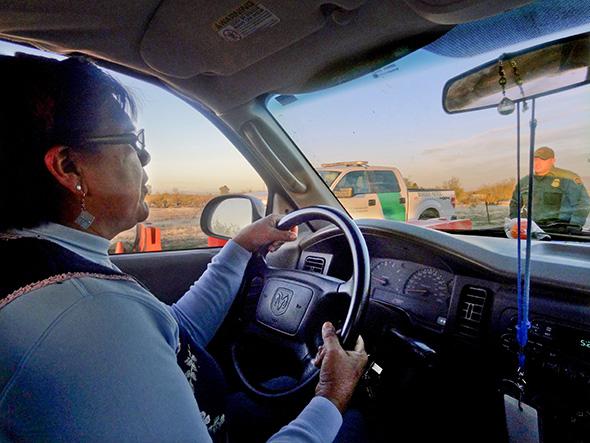ARIVACA, Ariz.—Carlota Wray squints against a sharp afternoon sun and navigates her pickup along Arivaca Road’s jutting curves and over rattling metal cattle guards. Wray, 56, has been driving this route, in and out of the valley between Arivaca and the rest of Arizona, for nearly her entire adult life.
She has nothing to hide—not underneath her blue sweater vest or in the panels of the car. Wray became a U.S. citizen in 2008 after years of permanent residency. Yet she still cleans out her car every time she sets off toward Tucson. She has to cross a checkpoint and will have to defend what she will never be able to conceal: her Mexican roots.
“I know that Border Patrol abuse Latinos, people with brown skin, as beautiful as God made us,” she says. “I see that my friends, my family are questioned and judged without reason, just for being Latino. They ask questions that are not necessary, but I am not doing anything wrong.”
The speed limit drops to 35 mph, the first warning of the upcoming checkpoint. All vehicles must stop. Drivers must use low beams. Wray pulls up along a string of neon-orange cones. “Slow down, slow down,” she says. “Hmm. I don’t see anybody. Today might be a lucky day. I don’t see anybody. Maybe they are in the car? Oh, there they are.”
A stocky uniformed man emerges from a shaded hut on the edge of the road and crosses to Wray’s window.
“How you doing?” he says, peering into the pickup.
“Doing good,” she says.
“U.S. citizens here?” the Border Patrol agent questions.
“U.S. citizens,” Wray says.
The agent nods, steps back and beckons us onward.
Wray exhales deeply, loosens her grip on the steering wheel, and presses on the gas.
A frontier war is being waged in southern Arizona, but it’s many miles north of the Mexico border. People are fed up with the immigration checkpoints. A round-the-clock U.S. Border Patrol presence at the checkpoints means that American citizens must endure inspection when they commute to work or run errands; every major road has one of these blockades.
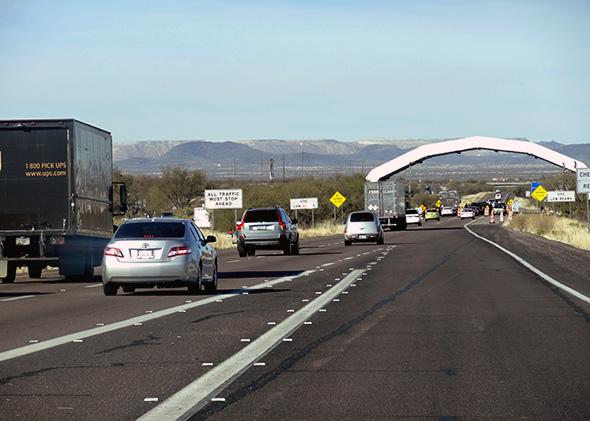
Photo by Amy Lieberman
Arizona may seem like an unlikely place for a backlash against immigration enforcement. The state is home to many aggressive immigration policies, like the controversial SB 1070 law, which gives Arizona police the right to demand citizenship papers from anyone they suspect is not in the U.S. legally. And recently Arizona residents have been protesting the arrival of undocumented children, some of the more than 52,000 unaccompanied minors who began to cross the border since October 2013, prompting President Barack Obama to declare a humanitarian crisis.

Photo by Kevork Djansezian/Reuters
Checkpoints deep inside the United States are inconceivable for most Americans who live far from the southwest. They are unknown even to some prominent immigration activists like Jose Antonio Vargas, an undocumented immigrant who was briefly detained at an interior checkpoint in Texas.
The Arizona checkpoints started springing up suddenly in early 2007 when Congress funded them after years of resistance from an Arizona politician. The checkpoints seem incongruous with a Western frontier ethos that equates open roads and fast cars with personal freedom.
“We are not accustomed to having a military checkpoint. It is common in other countries, but Americans have never had to live with that as a permanent way of life before,” says Leesa Jacobson, a co-founder of an anti-checkpoint community movement People Helping People in the Border Zone, based in Arivaca (population 700).
Parallel anti-checkpoint movements are drawing an odd collection of bedfellows—conservative ranchers, comfortable retirees, reclusive libertarians, and liberal activists—who are linked by one basic contention. Because American citizens can be randomly detained and searched at interior checkpoints deep inside the United States, the checkpoints undermine the tenets of a free, democratic society.
The exact number of interior checkpoints across the southwest isn’t easy to estimate. Some pop up and disappear on short notice. The Department of Homeland Security stopped releasing official numbers in 2008. The total number of interior checkpoints on the U.S.-Mexico and U.S.-Canada border areas may exceed 100, according to the Arizona Republic. In southern Arizona, there are at least 11, according to the American Civil Liberties Union, and they’re all positioned about 25 miles to 50 miles north of Mexico. The checkpoints operate round-the-clock, year-round as part of a border security strategy to apprehend undocumented migrants, stop illicit drugs and arms, and catch terrorists.
There is no uniform protocol or agreed law about what Border Patrol agents may do when they stop a motorist at an interior checkpoint.
The most commonly cited Supreme Court decision defining the rights of citizens and police is almost four decades old. The high court held in the 1976 case of U.S. v. Martinez-Fuerte that Border Patrol agents could “briefly question” all drivers about their citizenship at checkpoints and possibly request a form of identification, even “in the absence of any individualized suspicion,” but only at “reasonably located checkpoints.” Neither the vehicle nor its occupants should be searched without probable cause.
The federal government maintains that its agents have the right to ask drivers anything and physically search a vehicle, even if the driver is a U.S. citizen, because the Supreme Court held that “we can have checkpoints and they are not unreasonable,” says Shevannah Wray (no relation to Carlota Wray), a public affairs official for U.S. Customs and Border Protection.
The same case is cited in arguments that Border Patrol is exceeding its legal mandate.
“Basically it is clear [that it is OK for Border Patrol] to ask a few questions related to verifying the citizenship of a person, so long as the stop is not reasonably prolonged,” says James Duff Lyall, an ACLU of Southern Arizona staff attorney based in Tucson. “But what questions can they ask, really? What is unreasonably prolonged? Do you have to provide ID? That is not totally clear to me.”*

Photo by Amy Lieberman
In January the ACLU submitted an administrative complaint on behalf of 15 individuals to the Department of Homeland Security’s Office of Inspector General and Office for Civil Rights and Civil Liberties. The letter details alleged violations of U.S. citizens’ constitutional rights at six interior federal immigration checkpoints in Arizona. Most of the complainants say they were never questioned about their citizenship—the alleged purpose of the checkpoints—but were detained for a half hour or more for refusing to consent to an unwarranted search or for asking why they were being detained. One complainant says an officer drew a gun.
The ACLU also filed a lawsuit against DHS in April demanding immediate release of all records related to Border Patrol’s “extensive but largely opaque” interior enforcement operations in Tucson and Yuma patrol sectors. The federal agency responded in early July denying a release of the records. The case will now be brought to a U.S. District Court at the end of August. Lyall says the ACLU will not limit its focus to interior checkpoints in Arizona but will examine those in other states as well.
Many residents of Mexican origin believe they are routinely profiled when they are stopped at a checkpoint and asked to present identification.
“I’ve become so accustomed to it I don’t really pay attention to it anymore,” says Edith Cortez, a 26-year-old Mexican-American who lives in Sierra Vista, a city of about 40,000 that hugs two checkpoints. “I got questioned this one time, like ‘Is everybody a U.S. citizen? Are you sure?’ It was funny, like, just because of the way I look? You want to see my documentation? Go ahead.”
Yet the questions can sometimes range far afield: Did you cross into Mexico today? Are you the owner of this car? What kind of mileage does this car get? Where are you from? Where do you live? Where do you work?
Not everyone will answer. Some lone dissenters are choosing to take the risk of remaining silent.
Terry Bressi of the University of Arizona works on a mountain that towers more than 6,800 feet above the southern Arizona desert. He is a chief engineer for the Kitt Peak National Observatory, where he searches the nighttime sky for asteroids that could collide with the Earth. When Bressi travels home to Tucson, he must cross a federal immigration checkpoint on state Route 86, about 40 miles north of Mexico. He does not like it. But the checkpoint is unavoidable, so Bressi prepares for the encounter. He fastens six palm-sized video cameras onto the dashboard and rear window of his blue pickup.
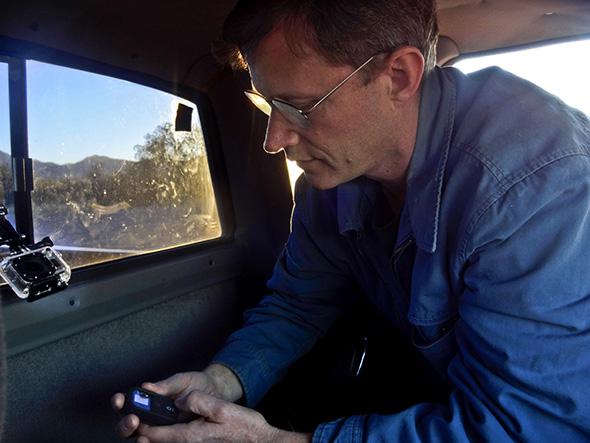
Photo by Amy Lieberman
“I am just a few miles outside of Three Points, Arizona,” he dictates into a recorder as he rolls down the mountain. “Uh, this particular checkpoint has been in place since early January 2008, and I have been documenting my experiences as I drive back and forth.”
Bressi has driven through the Route 86 fixed checkpoint about 350 times over the past six years and has never once rolled down his window to answer U.S. Border Patrol agents. His defiance has cost him thousands of dollars to fight traffic citations and a civil rights lawsuit.
He approaches the checkpoint, easing off the gas and gliding toward a line of Border Patrol vehicles. An agent approaches the truck, appears to recognize Bressi and retreats to confer with a colleague. He returns and silently waves him forward.
The Border Patrol has developed a protocol for handling motorists like Bressi. An agent will signal to a colleague and call out something like, “Hey guys, we are going to have an uncooperative motorist.” Backup agents are always nearby and usually help defuse the situation.
“It is not worth it to have the confrontation. We are seeing a lot more of these folks than we used to,” says the Interstate 19 checkpoint’s chief agent. (He asked not to be named because of security concerns. He looks to the hovering Santa Rita Mountains just north of the border, where he says the Mexican Sinaloa trafficking cartel lurks.)
Bressi posts videos of his checkpoint drive-throughs on his YouTube channel, CheckpointUSA. Bressi says YouTube has deleted a handful of the most dramatic videos, which he had used as evidence in his five settled and dismissed checkpoint court actions, charges for infractions like failure to obey an officer while directing traffic. Bressi suspects that a third-party complaint from Customs and Border Protection is to blame for YouTube’s removal of some of his videos.
There are a few other people like Bressi across the southwest: white, middle-aged men who keep steady jobs, are American citizens, and feel secure enough to routinely take a stand against checkpoints.
“I am not politically active,” says Richard Rynearson during a Skype call from South Korea. “I am a military officer, and I took an oath to defend the Constitution of the United States from foreign and domestic enemies. When I am deployed I focus on foreign enemies, and when I am here, I focus on the domestic ones.”*
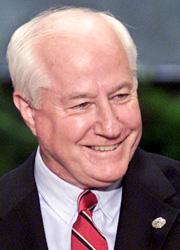
Photo by Gary Hershorn/Reuters
Rynearson, a major in the U.S. Air Force, is suing Border Patrol agents in Uvalde County, Texas, following a prolonged detention in 2010 at a checkpoint 67 miles north of the Mexico border. The detention and standoff with a Border Patrol agent landed him disciplinary action at work.
The simpler option for drivers is to comply with all requests.
Conflict over interior checkpoints in Arizona began in the mid-1990s. Then-Rep. Jim Kolbe, a Republican, helped block funding for permanent checkpoints within Arizona, considering it tactically foolish to place them far away from the actual border. But with Kolbe’s departure from office in 2007, the House of Representatives adopted appropriations language that approved funding for fixed interior checkpoints.
* * *
Retirees once flocked to Tubac for the year-round good weather, affordable adobe-style homes, and quaint outdoor shopping pavilions. But the checkpoint on I-19, a five-minute drive from town, has harmed real estate prices, according to a February 2013 study. Business owners also reported a decline following the construction of the checkpoint.
The Santa Cruz Valley Citizens Council is bringing a petition to close the checkpoint to Tubac’s chamber of commerce this summer. It plans to push the letter forward to lobby state representatives. So far, the council has received signatures of about 600 of the town’s population of 1,000.
Residents tell stories of drug mules passing through their backyards to avoid the checkpoint, walking in long lines down the streets. A high-speed car chase between a Border Patrol agent and migrants with a chaperoning coyote spilled over onto a pristine golf course in 2012. This is all a part of what locals call the checkpoint “fanning out” effect: Undocumented or possibly dangerous smugglers, rebuffed by checkpoints, filter out into surrounding communities.
It is unclear how truly effective the interior checkpoints or throngs of Border Patrol agents are at thwarting illegal activity. A few undocumented Mexican immigrants living in Winchester Heights, Arizona, told me they walked undetected across the border and around interior checkpoints a few years ago. It was not very difficult to travel on alternate dirt paths.

Photo by Amy Lieberman
Customs and Border Protection has gaps in its information about checkpoints that it needs to address, according to the U.S. Government and Accountability Office. It does not track data at individual checkpoints—only large regional sectors, which include border ports of entry. Nor do agents monitor how many cars pass through a checkpoint on a given day, says the chief of the I-19 stop.
On a Monday afternoon between 11 a.m. and 11:30 a.m., I counted 206 cars passing through the I-19 checkpoint, each stopped by two Border Patrol agents.
Thirty-eight of these drivers were questioned for at least 30 seconds and presented a form of identification. Only two or three of these drivers appeared to be light-skinned and fair-haired, as opposed to the overwhelming majority of these 38 drivers, who had brown hair and darker skin. Within this period, nine drivers were asked to pull over into a secondary area, all of whom drove a truck or van.
The People Helping People movement in Arivaca is currently sorting through data that community members have collected over the past few months on the profiles of motorists passing through the Arivaca Road checkpoint, located about 25 miles north of the Mexico border.
The I-19 chief says he is always looking three cars behind the one in front of him at the checkpoint, on alert for any strange, nervous behavior, like a jiggling leg, or a set of fingers drumming repeatedly against the steering wheel. But agents never stop people because they look as if they could have been born in Mexico or another part of Latin America, says Customs and Border Protection’s Shevannah Wray.
“That would be racism,” she says.
* * *
Undocumented Latinos organize their lives around the checkpoints, which now intercept every major road in southern Arizona. Laura Lopez (her name has been changed to protect her identity) has lived in Douglas, Arizona, since 1988. She cannot go north of Sierra Vista on state Route 90 because she will encounter a checkpoint and may be questioned about her citizenship. She cannot travel northwest on state Route 80, past Tombstone, because there, too, she will meet another checkpoint. There are more checkpoints along U.S. 191, near Elfrida, and east, heading toward New Mexico, on Route 80.
Lopez spends her days knitting or doing laundry. She cooks, mashing habanero chilies into fresh red salsa. She talks on the phone to the three of her five children who have been deported, one by one, back to Mexico, leaving the family half in the United States, half out, trapped between interior checkpoints.
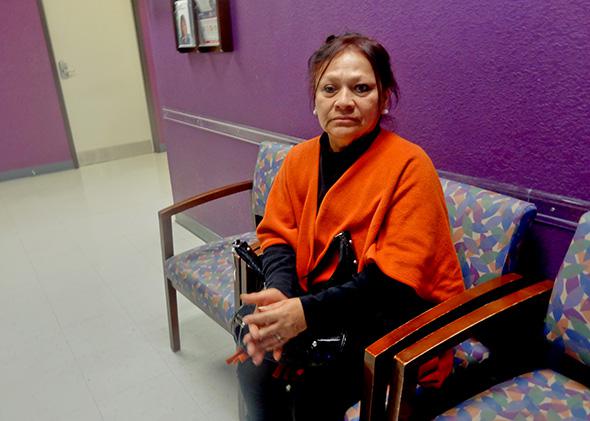
Photo by Amy Lieberman
“Now you cannot move to another part or travel around,” she says. “You begin to feel trapped because you cannot go out much. I cannot go to Mexico and I cannot go north. For me, this is very sad.”
Going back to Mexico would mean abandoning her younger children and husband, who are American citizens, and could place her health in jeopardy. Lopez was diagnosed with an aggressive form of breast cancer in 2009.
It can be a struggle to find medical programs specifically for women’s health in Sierra Vista, says Julie Encinas, a women’s health case manager at Chiricahua Community Health Center. The low-cost clinic tries to refer its mostly Latino patients to doctors on the same side of the checkpoints.
“If we refer someone elsewhere, we always ask, ‘Can you get there, is there anything that can keep you from getting there?’ ” says Jane Davenport, a nurse practitioner who works for the Chiricahua Health Center’s Douglas mobile branch. “A handful of people have said, ‘No, but we will get there,’ meaning they will just take a chance.”
Lopez is one of the patients who took a chance and accepted a ride from family friends to Phoenix. She cried throughout the one-hour drive until they approached an Army green–clad Border Patrol agent under the checkpoint’s white arch. He asked where they were going and where they were coming from. Lopez, in the backseat, quietly listened to the conversation. It played out in Spanish, the only language she speaks.
“They spoke to him like family, my friends. They said ‘Hijo, we are coming from Douglas and we are going to Tucson.’ He said ‘OK’ and then we passed,” she says, exhaling deeply. “Thank God it was easy. Because of my health, my children and everything, my husband.”
Lopez’s cancer is in remission. She worries that it will return or complications from diabetes will require another journey to Phoenix. For now, Lopez is stuck in her house, measuring out pills that prevent her blood sugar from spiking.
* * *
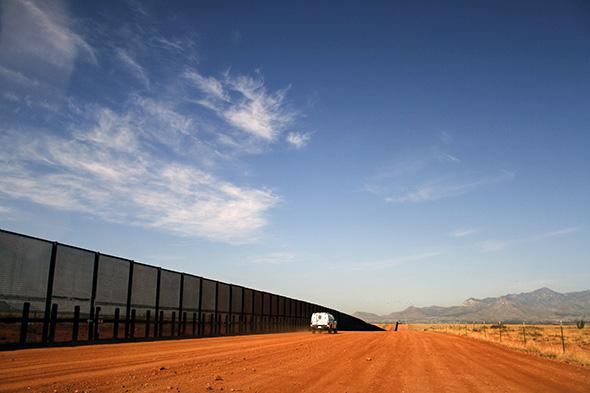
Photo by Joshua Lott/Reuters
The checkpoint fighters in Arizona rage against several targets. There is the Border Patrol, swelling in its ranks and funding, facing accounts of corruption and poor treatment of civilians. There are the failed efforts at border security and immigration reform. And then there are the actual checkpoints themselves: The insecure shacks that must be shuttered during summer storms, and the hulking, white arches that provide relief for the K-9s during hot afternoons. These fixtures remain largely outside of Arizona and national politics, says an adviser to Arizona Rep. Raúl Grijalva, in part because of how they contradict political ideologies. The opposition is not led by liberals or conservatives or defined by their traditional leanings. The ire is localized and yet transcendent, passing from car to car on Arizona roads.
Crossing an interior immigration checkpoint in Arizona is a puzzling experience. A curious visitor from a peaceful foreign country driving around the state who happened upon a checkpoint for the first time might well wonder, on the basis of the cursory questions and inspections, why, exactly, the checkpoints are present. Visitors from countries wracked by military rule, coups, or civil wars, where checkpoints are routine instruments of control—and sometimes sites of violence and extortion—might feel more at home.
When an agent gives the OK—a nod, a “have a good day, now”—a traveler cannot help but feel a surge of virtue or a rush of relief.
Arivaca seems an unlikely place for an effective checkpoint resistance movement to take hold. The town is a dot on a map, nestled in the desert 14 miles north of Mexico. A community office along the town’s dusty main street collects complaints from checkpoint crossers. As soon as the office first opened in 2012, people started coming by to “say something terrible happened with Border Patrol at the checkpoint,” recalls Sophie Smith, 27, one of the co-founders of the office. The reports poured in, revolving around prolonged detentions, abusive language, and physical force.
Border Patrol agents work 8- to 10-hour shifts and rotate checkpoint locations every few days. That makes it difficult for them to recognize and wave through local residents who regularly pass through checkpoints, as the somewhat speculative Supreme Court ruling from 1976 originally contemplated.
The agents themselves can be on edge. There is a “100 percent chance” of injury on the job, says an agent at the Arivaca Road checkpoint who asks not to be identified for security reasons. It is just a matter of whether you will be run over by a car, or attacked by a criminal who discovers where you live, he says.
“I’ve arrested maybe 20,000 over the past 10 years and some of those people have been apprehended, what, once, two times?” he says. “They remember my face. I don’t remember theirs. They could find me. Show up at my home, find my family.”
About a third of Arivaca residents have signed a petition to close the checkpoint.
Carlota Wray is one of them. Over a meal of fresh tamales at her relatives’ house, Wray’s brother-in-law, Manuel Leyva, a legal permanent resident in the United States, surprises her by saying he has no problem with Border Patrol agents sometimes questioning his 14-year-old daughter, an American citizen, at the Arivaca Road checkpoint and asking for her passport.
“We are taught to respect the authorities and to respect men in uniform in Mexico,” he says.
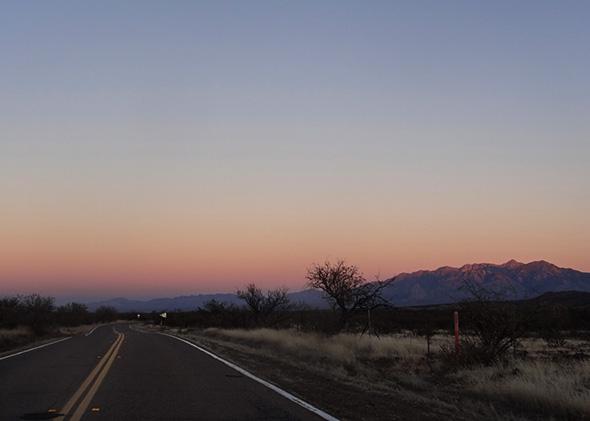
Photo by Amy Lieberman
Later, on the way home, Wray muses in the quiet of the dark car. Her thoughts drift to one April evening in 2012. She and her oldest daughter, Yolanda, were rushing her elderly mother to the hospital in Tucson. Wray had obtained a short-term visa for her mother, a Mexican citizen, whose liver was failing.
They paused at the checkpoint and rolled down the window to greet a Border Patrol agent.
“This man, he asked if I was a citizen and the words did not come and he looked at me, and I looked at him, and he saw my tears come, and it was this awful moment,” says Wray. “He asked me, ‘Where are you going? Where are you taking her?’ All I could think about was my mother. It was an awful intrusion.”
Wray attends anti-checkpoint meetings regularly, but Yolanda never does.
“Yolanda has an attitude like, ‘If you behave well, then they will treat you well,’ ” Wray says from the car. “She and my granddaughter have become accustomed to it. That is a bad idea.”
Wray now nears the checkpoint, for the second time today. White fluorescent lights towering overhead cast beams inside her Dodge. She catches a glimpse of Border Patrol’s foldout chairs near a white trailer. No agents emerge. She keeps on driving toward Arivaca, and the checkpoint gradually falls out of view.
Correction, July 21, 2014: This article originally misquoted Richard Rynearson as saying “I am a military officer, and I took an oath to defend foreign and domestic entities.” He said “I am a military officer, and I took an oath to defend the Constitution of the United States from foreign and domestic enemies.” (Return.) It also misquoted James Duff Lyall as questioning what a “reasonably prolonged” checkpoint stop is. He questioned what an “unreasonably prolonged” one is. (Return.)
